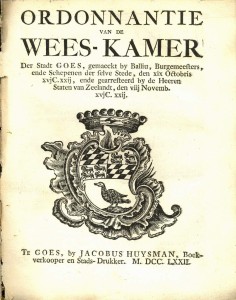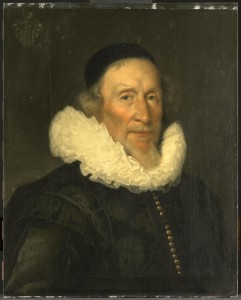
Ordinance of the Goes Orphan Chamber. Image credits: Goes Municipal Archives
A weeskamer is the orphan chamber, a government body responsible for overseeing the administration of the estates of (half) orphans. Weeskamers should not be confused with orphanages: they did not take care of the orphans, just the administration of the estates.
Weeskamers existed in most parts of the Netherlands until 1810. After 1810, their tasks were taken over by the court. They also existed in Dutch colonies, like New Amsterdam (present-day New York).
Tasks of the orphan chamber
After a parent died, the Weeskamer oversaw that a guardian was appointed. The first task of the guardian was to create an inventory of the estate that was left behind to determine the inheritance that the orphan was entitled to. The surviving spouse could pay the orphans their share and settle the inheritance, or could administer the estate until the children became of age (usually at age 25 for boys and 20 for girls). At that time, the guardian would submit a final settlement that showed how the estate had been divided.
When a widow or widower remarried, he or she needed to submit a statement from the Weeskamer that the children of the previous marriage had received their share, or arrangements had been made to safeguard their inheritance. Sometimes you see a statement that they were so poor that the children did not receive an inheritance.
Weeskamer records

Jacob Gerritsz van der Mij, orphan master in Leiden. Image credits: Geheugen van Nederland
Weeskamer records can be a great source of information about family relationships, often giving the names and ages of the children. Administrators and guardians were often close relatives and sometimes the estate included shares in inheritances of previous generations. The inventories also provide an insight into the material wealth of our ancestors.
My favorite Weeskamer record find is an 18th century inventory of one of my ancestors that showed she owned two tea sets. I am a great lover of tea so perhaps I inherited that from her. Too bad I did not inherit her tea set too!


I have been looking for Weeskamer records for a long time. I was so excited to get this weeks newsletter that talks about them! My question is, where can I find the Weeskamer records for Amsterdam?
Hi Bobbie,
Great to read that you enjoyed the topic. The archives of the Weeskamer of Amsterdam are kept at the Amsterdam Municipal Archives. The finding aid (catalog) is available online. Section 2.9.1.1 contains the lists of orphans overseen by the orphan chamber. Several call numbers have been digitized and are available via pay-per-view. Unfortunately, these records have not been indexed. There are some contemporary (18th century) alphabetical indexes on the names of the deceased or guardians but browsing these scans can take quite a bit of money. I usually consult them at the Amsterdam City Archives reading room, where these scans can be accessed for free.
Your tip on orphans was very timely since it coincided with my discovering with reference to guardians in a marriage record. My grandfather and his siblings were orphaned in May, 1873 when their mother died. Their father had died the previous November. When his sister Janke Hanzes Zandstra was married in February, 1916. Two guardians were mentioned in the marriage register. One was Janke’s paternal uncle and the other was the husband of her maternal aunt. The wording was “… hebbende tot voogt Oeds Barteles Zandstra daglooner wonende te Eestrum, en tot toeziende voogd Sijtze Taekes Ziijlstra, landbouwer wonende aldaar, ten dezen met haar voogd en toeziende voogd gesterkt.” I’m not sure why there were 2 guardians and what their functions were, expecially in regard to the marriage.
I have an ancestor born 1786 with siblings born up to 1792. Their parents died in 1796 and 1801 in Olst, Overijssel. Where would you find the Weeskamer records?
My great grandma father was born van eps in late 1800s. I was told he went to live with a family by the name or Harmon and his brother to a family named Johnson. Was this a common practice for the Dutch? No records can be found. I am certain he was born in the US but how would I ever find information on his father van eps?